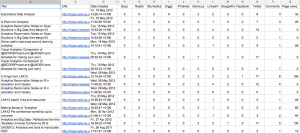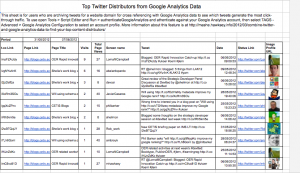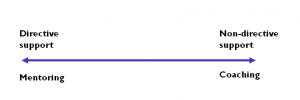As I’ve mentioned before, CETIS are in the middle of a piece of work for JISC around analytics in education (our Analytics Reconnoitre project). You may have noticed a number of blog posts from myself and colleagues around various aspects of analytics in education. We think this is a “hot topic” but is it? Can our analytics help us to gauge interest?
CETIS, like many others, is increasingly using Google Analytics to monitor traffic on our website. We are also lucky to have in Martin Hawksey, a resident google spreadsheet genius. Since Martin has come to work with us, we have been looking at ways we can use some of his “stuff” to help us develop our communications work, and gain more of an understanding of how people interact with our overall web presence.
As part of the recent CETIS OER visualisation project, Martin has explored ways of tracking social sharing of resources. Using this technique Martin has adapted one of his spreadsheet so that it not only takes in google analytics from our CETIS blog posts, but also combines the number of shares a post is getting from these social sharing sites: Buzz, Reddit, Stumbleupon, Diggs, Pinterest, Delicious, Google+, Facebook and Twitter. By adding the the rss feed from our Analytics topic area, we get a table like this which combines the visit and comments information with the number of shares a post gets on each of the sharing sites.

(NB Martin’s blog is not hosted on our CETIS server so we can’t automagically pull his page view info in this way which is why there is a 0 value in the page view column for his posts, but I think we can safely say that he gets quite a few page views)
From this table it is apparent that Twitter is the main way our posts are being shared. Linkedin comes in second with delicious and google+ also generating a few “shares”. The others get virtually no traffic. We already knew that twitter is a key amplification tool for us, and again Martin’s magic has allowed us to create a view of the top click throughs from Twitter on our blog posts.

We could maybe be accused of playing the system, as you can see a number of our top re-tweeters are staff members – but if we can’t promote our own stuff, then we can hardly expect anyone else to!
But I digress, back to the main point. We can now get an overview of traffic on a particular topic area, and see not only the number of visits and comments it is getting but also where else it is being shared. We can then start to make comparisons across topic areas.
This is useful on a number of levels beyond basic web stats. Firstly, it gives us another view on how our audience shares and values our posts. I think we can say that if someone book marks a post, they do place some value on it. I would hesitate to start to quantify what that value is, but increasingly we are being asked about ROI so it is something we need to consider. Similarly with re-tweets, if something is re-tweeted they people want to share that resource and so feel that it is of value to their twitter network. I don’t see a lot of bot retweets in the my network. It also allows us to share and evaluate more information not only internally, but also with our funders (and through posts like this) our community.
It also raises some questions wider questions about resource sharing and web analytics in general. Martin raised this issue last year with this post which sparked this reply from me. The questions I raised there are still on my mind, and increasingly as I explore this more in the context of CETIS, I think I am beginning to see more evidence of the habits and practice of our community.
Twitter is a useful dissemination channel, and increasingly a key way for peer sharing of information. The use of other social sharing sites, would appear to be not so much. Tho’ I was surprised to see relatively high numbers for linked in. Again this might be down to the “professional” nature of linked in – or the fact that I am an unashamed social media tart, and repost all my blog posts in linked in too  We also have sharing buttons on the bottom of our posts which have very obvious buttons for twitter, linked in and Facebook.
We also have sharing buttons on the bottom of our posts which have very obvious buttons for twitter, linked in and Facebook.
In terms of other social sharing sites, are these just more a question of people’s own work practices and digital literacies? Are these spaces seen as more private? Or is it just that people still don’t really use them that much, did the delicious debacle affect our trust in such sites? Should we encourage more sharing by having more obvious buttons for the other sites listed in the table? And more importantly should JISC and its funded services and projects be looking towards these sites for more measures of impact and engagement? Martin’s work illustrates how you can relatively easily combine data from different sources, and now there are some templates available there really isn’t a huge time cost to adapt them, but are they gathering the relevant data? Do we need to actively encourage more use of social sharing sites? I’d be really interested to hear of any thoughts/ experiences other have of any of these issues.



